check engine SKODA SUPERB 2009 2.G / (B6/3T) Owner's Guide
[x] Cancel search | Manufacturer: SKODA, Model Year: 2009, Model line: SUPERB, Model: SKODA SUPERB 2009 2.G / (B6/3T)Pages: 294, PDF Size: 21.33 MB
Page 226 of 294

Inspecting and replenishing
225
Using the system
Safety
Driving Tips
General Maintenance
Breakdown assistance
Technical Data
– Wait a few minutes and pull out the oil dipstick. – Wipe off the dipstick with a clea
n cloth and insert it again fully.
– Then withdraw the dipstick ag
ain and read off the oil level.
Oil level within range – You must
not
top up the oil.
Oil level within range – You
may
top up the oil. It is possible that the oil level may then be
within range after doing this.
Oil level within range – You
must
top up the oil
⇒
page 225. It is sufficient, once this is done,
to keep the oil level within range .
It is normal for the engine to consume oi
l. The oil consumption may be as much as
0.5 l/1 000 km depending on your style of
driving and the conditions under which
you operate your vehicle. Th
e oil consumption may be sl
ightly higher than this
during the first 5 000 kilometres. One should therefore check the oil level at regular intervals, preferably every time after the fuel tank is filled or after driving for long stretches. We recommend maintaining the oil level within the range -
but not above this
,
if the engine has been operating at high loads, for example during a lengthy motorway trip during the
summer months, towing a trai
ler or negotiating a high
mountain pass. The warning light in the instrument cluster* will indicate
⇒page 42, “Engine oil
level
” whether the oil level is too low. In this case, check the oil level as soon as
possible. Top up with an appropriate quantity of oil.
Caution
•
The oil level must on no account ex
tend beyond the ra
nge . Danger of
damaging the catalytic converter.
•
Do not continue your journey
if for some reason it is not possible under the
conditions prev
ailing to top up with oil.
Switch of the engine and contact
and
obtain professional assistance from a specialist garage.
Note
Engine oil specifications
⇒page 270.
Replenishing engine oil– Inspecting the engine oil level
⇒
page 224.
– Unscrew the cap of the engine oil filler opening.– Pour in a suitable grade of oil in portions of 0.5 litres
⇒
page 270.
– Inspect the oil level
⇒
page 224, “Check engine oil level”.
– Carefully screw on the cap of the filler opening and push the dipstick
in fully.
WARNING
•
Avoid dripping oil onto hot parts of the engine when topping up will oil -
a risk of fire!•
Read and observe the warning notes
⇒page 223, “Working in the engine
compartment” before working in the engine compartment.
For the sake of the environment
The oil level must on no account be above the range
⇒page 224. Oil will other-
wise be drawn in through the crankcas
e ventilation and may pass through the
exhaust system to atmosphere. The oil ma
y combust in the catalytic converter and
damage it.
AAAB
AA
AC
AB
AA
AA
Aa
s2dk.1.book Page 225 Wednesday, April 8, 2009 12:23 PM
Page 228 of 294
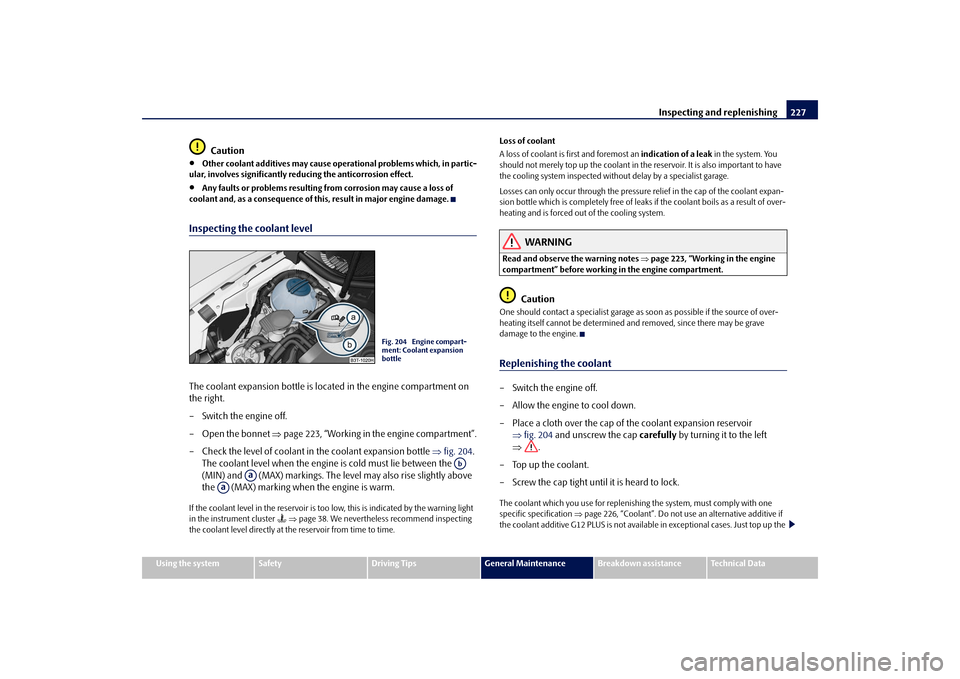
Inspecting and replenishing
227
Using the system
Safety
Driving Tips
General Maintenance
Breakdown assistance
Technical Data
Caution
•
Other coolant additives may cause operational problems which, in partic-
ular, involves significantly redu
cing the anticorrosion effect.
•
Any faults or problems resulting from corrosion may cause a loss of
coolant and, as a consequence of th
is, result in major engine damage.
Inspecting the coolant levelThe coolant expansion bott
le is located in the engine compartment on
the right. – Switch the engine off. – Open the bonnet
⇒
page 223, “Working in the engine compartment”.
– Check the level of coolant in
the coolant expansion bottle
⇒
fig. 204
.
The coolant level when the engine is cold must lie between the (MIN) and (MAX) markings. The level may also rise slightly above the (MAX) marking when the engine is warm.
If the coolant level in the reservoir is too low, this is indicated by the warning light in the instrument cluster
⇒page 38. We nevertheless recommend inspecting
the coolant level directly at the reservoir from time to time.
Loss of coolant A loss of coolant is first and foremost an
indication of a leak
in the system. You
should not merely top up the coolant in the
reservoir. It is also important to have
the cooling system inspected without delay by a specialist garage. Losses can only occur through the pressure relief in the cap of the coolant expan- sion bottle which is completely free of leak
s if the coolant boils as a result of over-
heating and is forced out of the cooling system.
WARNING
Read and observe the warning notes
⇒page 223, “Working in the engine
compartment” before working in the engine compartment.
Caution
One should contact a specialist garage as
soon as possible if the source of over-
heating itself cannot be determined
and removed, since there may be grave
damage to the engine.Replenishing the coolant– Switch the engine off. – Allow the engine to cool down.– Place a cloth over the cap of the coolant expansion reservoir
⇒
fig. 204
and unscrew the cap
carefully
by turning it to the left
⇒
.
– Top up the coolant. – Screw the cap tight until it is heard to lock.The coolant which you use for replenishi
ng the system, must comply with one
specific specification
⇒page 226, “Coolant”. Do not use an alternative additive if
the coolant additive G12 PLUS is not available in exceptional cases. Just top up the
Fig. 204 Engine compart- ment: Coolant expansion bottle
Ab
Aa
Aa
s2dk.1.book Page 227 Wednesday, April 8, 2009 12:23 PM
Page 234 of 294

Inspecting and replenishing
233
Using the system
Safety
Driving Tips
General Maintenance
Breakdown assistance
Technical Data
Charging the battery A properly charged battery is essential for reliably starting the engine.–Read the warning notes
⇒
in “Working on the battery” on
page 229 and
⇒
.
– Switch the ignition and all
electrical components off.
– Only for “quick-charging”: Disconnect
both battery cables (first of all
“negative”, then “positive”).
– Carefully attach the terminal clam
ps of the charger to the battery
terminals (red = “positive”, black = “negative”).
– You can now plug the mains cable of the charger into the power socket
and switch on the charger.
– When charging is completed: switch the charger off and unplug the
mains cable from the power socket.
– Only then should you disconnect the terminal clamps of the charger.– Reconnect the cables to the battery
(first of all “positive”, then “nega-
tive”).
It is not normally necessary
to disconnect the cables of the battery if you recharge
the battery using low ampera
ges (as for example from a
mini-charger
). Please also
refer to the instructions from the charger manufacturer. A charging current of 0.1 of the total batter
y capacity (or lower) is that which should
be used until full charging is achieved. It is, however, necessary to disconnect both
cables before charging the battery with
high amperages, so-called “
quick-charging
”.
“Quick-charging” a battery is
dangerous
⇒
in “Working on the battery” on
page 229. It requires a special charger and appropriate knowledge. We therefore re c o m m e n d t h a t y o u h a v e y o u r b a t t e r y q u i c k - c h a rg e d o n l y b y a n a u t h o ri s e d Š ko d a Service Partner.
A discharged battery may already
freeze
at temperatures just below 0°C
⇒
. We
recommend that you no longer use a ba
ttery which has thawed out because the
casing of the battery may be cracked through the formation of ice and this would allow battery electrolyte to flow out. The vent plugs of the battery shou
ld not be opened for charging.
WARNING
Never charge a frozen or thawed battery - risk of explosion and caustic burns. Replace a frozen battery.Disconnecting and reconnecting the batteryOn disconnecting and reconnecting the battery the following functions are initially deactivated or are no longer able to operate fault-free. We recommend having the vehicle checked by an authorised Škoda Service Partner to ensure full functionality of all electrical systems.Replacing the batteryYou should only replace a battery with a
new battery of the same capacity, voltage
(12 V), amperage and of the same size. The authorised Škoda Service Partners have a range of suitable batteries available. We recommend that you only have an old
battery disposed of by an authorised
Škoda Service Partner since it does require special disposal.Operation
Operating measure
Electrical power window
(operational faults)
⇒page 56
Enter radio code number
see Radio Operating Instructions
Set hours
⇒page 21
Data in the multi-functional indicator* are deleted.
⇒ page 21
s2dk.1.book Page 233 Wednesday, April 8, 2009 12:23 PM
Page 247 of 294
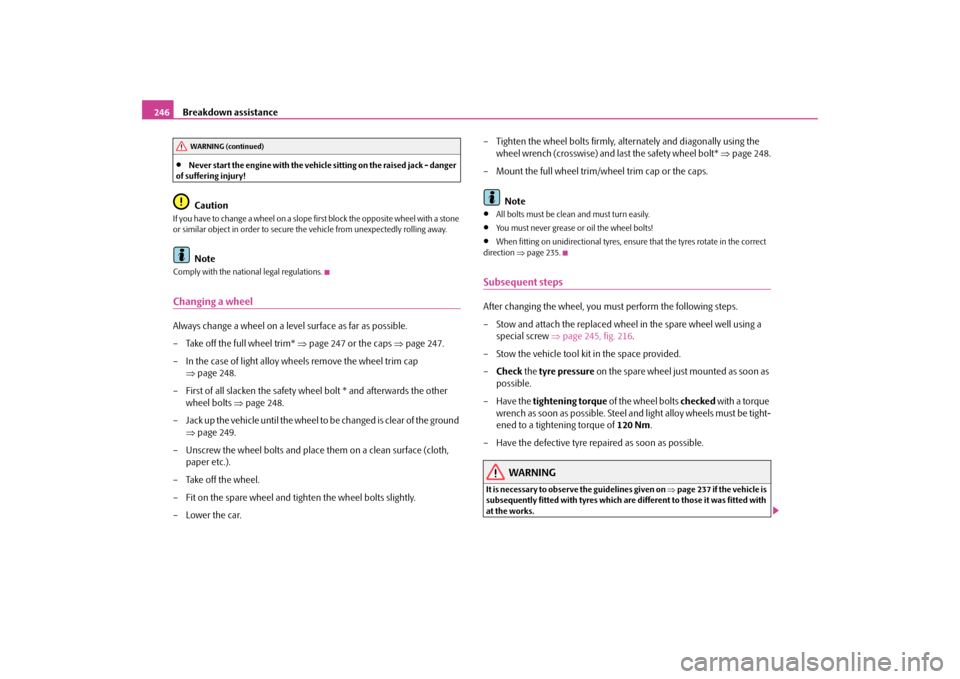
Breakdown assistance
246
•
Never start the engine with the vehicle
sitting on the raised jack - danger
of suffering injury!
Caution
If you have to change a wheel on a slope
first block the opposite wheel with a stone
or similar object in order to secure th
e vehicle from unexpectedly rolling away.
Note
Comply with the national legal regulations.Changing a wheelAlways change a wheel on a level surface as far as possible. – Take off the full wheel trim*
⇒
page 247 or the caps
⇒
page 247.
– In the case of light alloy wheels remove the wheel trim cap
⇒
page 248.
– First of all slacken the safety wh
eel bolt * and afterwards the other
wheel bolts
⇒
page 248.
– Jack up the vehicle until the wheel to
be changed is clear of the ground
⇒
page 249.
– Unscrew the wheel bolts and place them on a clean surface (cloth,
paper etc.).
– Take off the wheel. – Fit on the spare wheel and tighten the wheel bolts slightly. –Lower the car.
– Tighten the wheel bolts firmly, al
ternately and diagonally using the
wheel wrench (crosswise) and last the safety wheel bolt*
⇒
page 248.
– Mount the full wheel trim/w
heel trim cap or the caps.
Note
•
All bolts must be clean
and must turn easily.
•
You must never grease or oil the wheel bolts!
•
When fitting on unidirectional tyres, ensure that the tyres rotate in the correct
direction
⇒page 235.
Subsequent stepsAfter changing the wheel, you must perform the following steps. – Stow and attach the replaced wheel in the spare wheel well using a
special screw
⇒
page 245, fig. 216
.
– Stow the vehicle tool kit in the space provided.–
Check
the
tyre pressure
on the spare wheel just mounted as soon as
possible.
– Have the
tightening torque
of the wheel bolts
checked
with a torque
wrench as soon as possible. Steel and light alloy wheels must be tight-ened to a tightening torque of
120 Nm
.
– Have the defective tyre repaired as soon as possible.
WARNING
It is necessary to observe the guidelines given on
⇒page 237 if the vehicle is
subsequently fitted with tyres which are
different to those it was fitted with
at the works.
WARNING (continued)
s2dk.1.book Page 246 Wednesday, April 8, 2009 12:23 PM
Page 251 of 294
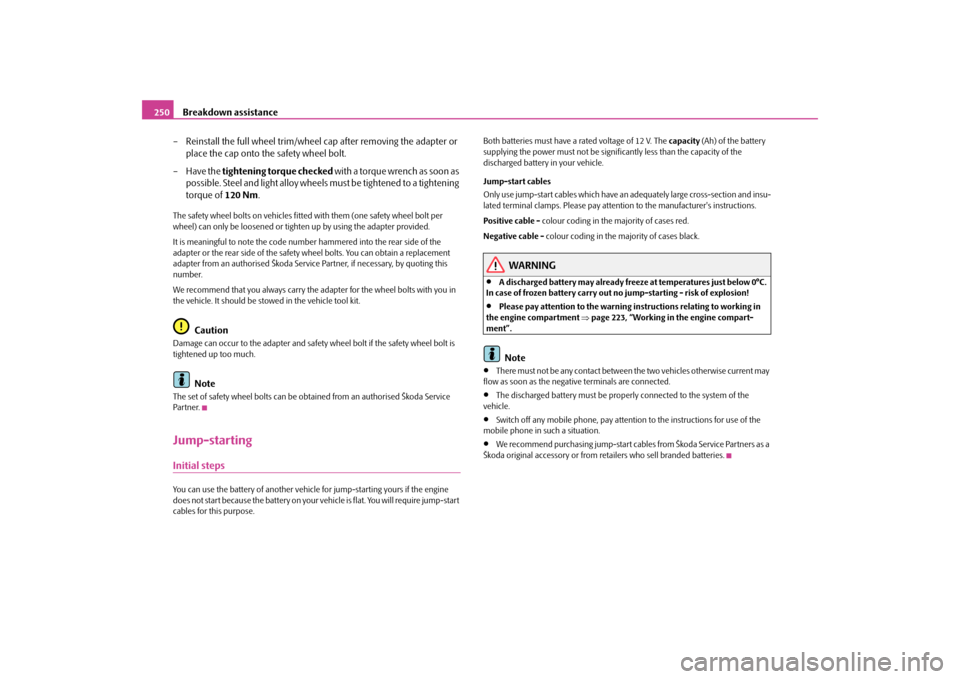
Breakdown assistance
250
– Reinstall the full wheel trim/wheel cap after removing the adapter or
place the cap onto the safety wheel bolt.
– Have the
tightening torque
checked
w i t h a t o rq u e w re n c h a s s o o n a s
possible. Steel and light alloy wheels must be tightened to a tightening torque of
120 Nm
.
The safety wheel bolts on vehicles fitted with them (one safety wheel bolt per wheel) can only be loosened or tigh
ten up by using the adapter provided.
It is meaningful to note the code numbe
r hammered into the rear side of the
adapter or the rear side of the safety wheel bolts. You can obtain a replacement adapter from an authorised Škoda Service Partner, if necessary, by quoting this number. We recommend that you always carry the
adapter for the wheel bolts with you in
the vehicle. It should be st
owed in the vehicle tool kit.
Caution
Damage can occur to the adapter and safety
wheel bolt if the safety wheel bolt is
tightened up too much.
Note
The set of safety wheel bolts can be obta
ined from an authorised Škoda Service
Par tner.Jump-startingInitial stepsYou can use the battery of another vehicl
e for jump-starting yours if the engine
does not start because the battery on your
vehicle is flat. You will require jump-start
cables for this purpose.
Both batteries must have a rated voltage of 12 V. The
capacity
(Ah) of the battery
supplying the power must not be signific
antly less than the capacity of the
discharged battery
in your vehicle.
Jump-start cables Only use jump-start cables which have an
adequately large cross-section and insu-
lated terminal clamps. Please pay attent
ion to the manufacturer's instructions.
Positive cable -
colour coding in the
majority of cases red.
Negative cable -
colour coding in the majority of cases black.
WARNING
•
A discharged battery may already freeze
at temperatures just below 0°C.
In case of frozen battery carry out no jump-starting - risk of explosion!•
Please pay attention to the warning instructions relating to working in
the engine compartment
⇒page 223, “Working in the engine compart-
ment”.
Note
•
There must not be any contact between the two vehicles otherwise current may
flow as soon as the negative terminals are connected.•
The discharged battery must be proper
ly connected to the system of the
vehicle.•
Switch off any mobile phone, pay attent
ion to the instructions for use of the
mobile phone in such a situation.•
We recommend purchasing jump-start cabl
es from Škoda Service Partners as a
Škoda original accessory or from retailers who sell branded batteries.
s2dk.1.book Page 250 Wednesday, April 8, 2009 12:23 PM
Page 257 of 294
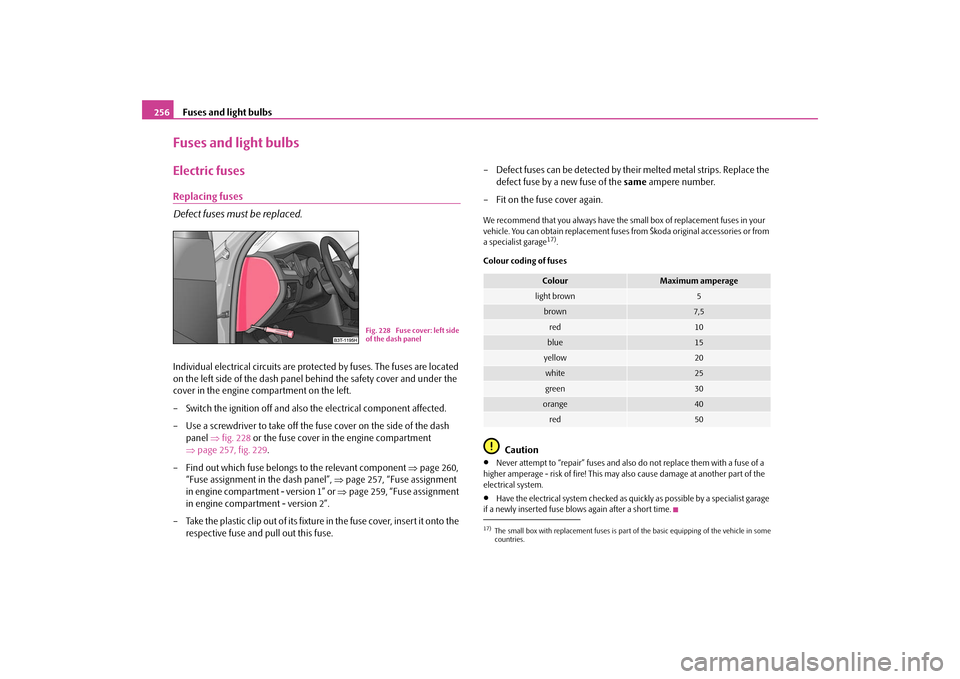
Fuses and light bulbs
256
Fuses and light bulbsElectric fusesReplacing fuses Defect fuses must be replaced.Individual electrical circuits are prot
ected by fuses. The fuses are located
on the left side of the dash panel behind the safety cover and under the cover in the engine compartment on the left. – Switch the ignition off and also the electrical component affected.– Use a screwdriver to take off the fuse cover on the side of the dash
panel
⇒
fig. 228
or the fuse cover in the engine compartment
⇒
page 257, fig. 229
.
– Find out which fuse belongs to the relevant component
⇒
page 260,
“Fuse assignment in the dash panel”,
⇒
page 257, “Fuse assignment
in engine compartment - version 1” or
⇒
page 259, “Fuse assignment
in engine compartment - version 2”.
– Take the plastic clip out of its fixture in the fuse cover, insert it onto the
respective fuse and pull out this fuse.
– Defect fuses can be detected by th
eir melted metal st
rips. Replace the
defect fuse by a new fuse of the
same
ampere number.
– Fit on the fuse cover again.We recommend that you always have the
small box of replacement fuses in your
vehicle. You can obtain replacement fuses from Škoda original accessories or from a specialist garage
17).
Colour coding of fuses
Caution
•
Never attempt to “repair” fuses and also do not replace them with a fuse of a
higher amperage - risk of fire! This may
also cause damage at another part of the
electrical system.•
Have the electrical system checked as quickly as possible by a specialist garage
if a newly inserted fuse blows again after a short time.
Fig. 228 Fuse cover: left side of the dash panel
17)The small box with replacement fuses is part of the basic equipping of the vehicle in somecountries.
Colour
Maximum amperage
light brown
5
brown
7,5
red
10
blue
15
yellow
20
white
25
green
30
orange
40
red
50
s2dk.1.book Page 256 Wednesday, April 8, 2009 12:23 PM
Page 280 of 294
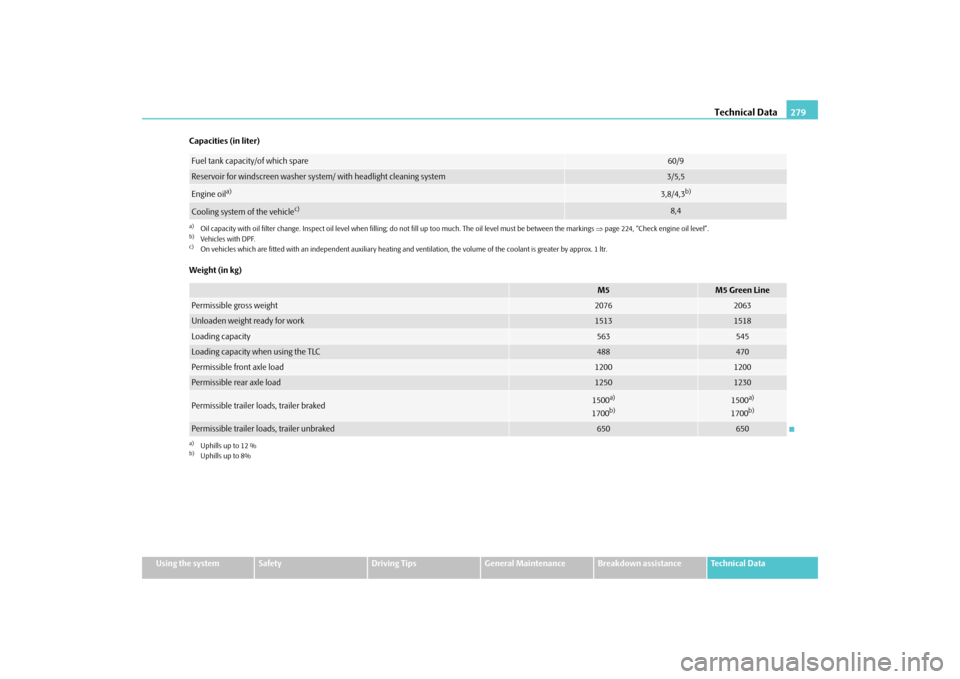
Technical Data
279
Using the system
Safety
Driving Tips
General Maintenance
Breakdown assistance
Technical Data
Capacities (in liter) Weight (in kg)Fuel tank capacity/of which spare
60/9
Reservoir for windscreen washer system/ with headlight cleaning system
3/5,5
Engine oil
a)
a)Oil capacity with oil filter change. Inspect oil level when fi
lling; do not fill up too much. The oil level must be between the
markings
⇒page 224, “Check engine oil level”.
3,8/4,3
b)
b)Ve hicles w ith DP F.Cooling system of the vehicle
c)
c)On vehicles which are fitted with an indepe
ndent auxiliary heating and ventilation, the
volume of the coolant is greater by app
rox. 1 ltr.
8,4
M5
M5 Green Line
Permissible gross weight
2076
2063
Unloaden weight ready for work
1513
1518
Loading capacity
563
545
Loading capacity when using the TLC
488
470
Permissible front axle load
1200
1200
Permissible rear axle load
1250
1230
Permissible trailer loads, trailer braked
1500
a)
1700
b)
a)Uphills up to 12 %b)Uphills up to 8%
1500
a)
1700
b)
Permissible trailer loads, trailer unbraked
650
650
s2dk.1.book Page 279 Wednesday, April 8, 2009 12:23 PM
Page 282 of 294
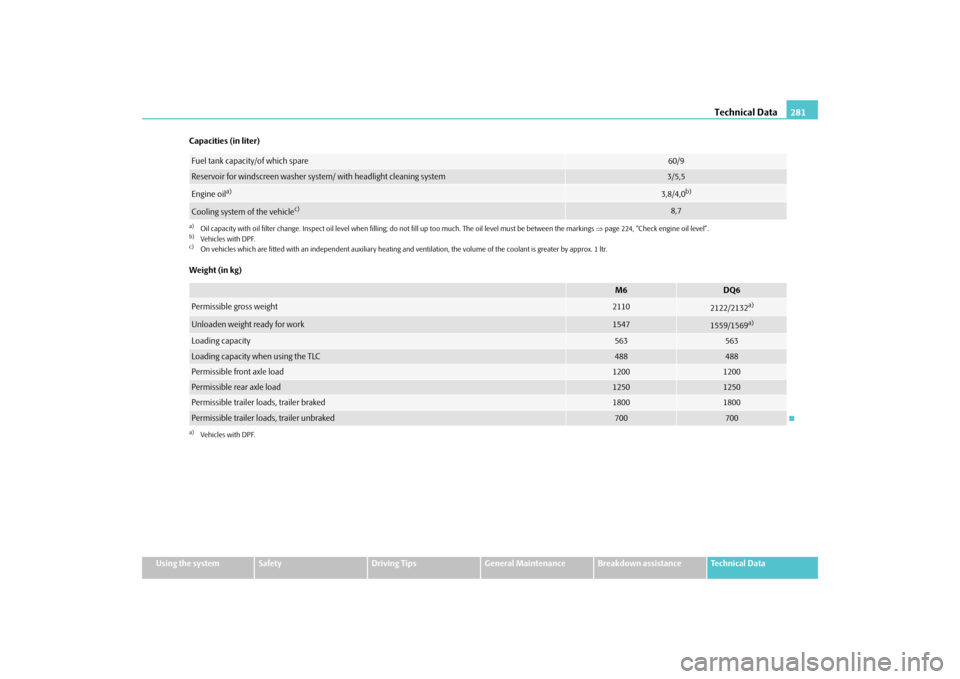
Technical Data
281
Using the system
Safety
Driving Tips
General Maintenance
Breakdown assistance
Technical Data
Capacities (in liter) Weight (in kg)Fuel tank capacity/of which spare
60/9
Reservoir for windscreen washer system/ with headlight cleaning system
3/5,5
Engine oil
a)
a)Oil capacity with oil filter change. Inspect oil level when fi
lling; do not fill up too much. The oil level must be between the
markings
⇒page 224, “Check engine oil level”.
3,8/4,0
b)
b)Ve hicles w ith DP F.Cooling system of the vehicle
c)
c)On vehicles which are fitted with an indepe
ndent auxiliary heating and ventilation, the
volume of the coolant is greater by app
rox. 1 ltr.
8,7
M6
DQ6
Permissible gross weight
2110
2122/2132
a)
a)Ve hicles w ith DP F.Unloaden weight ready for work
1547
1559/1569
a)
Loading capacity
563
563
Loading capacity when using the TLC
488
488
Permissible front axle load
1200
1200
Permissible rear axle load
1250
1250
Permissible trailer loads, trailer braked
1800
1800
Permissible trailer loads, trailer unbraked
700
700
s2dk.1.book Page 281 Wednesday, April 8, 2009 12:23 PM
Page 287 of 294
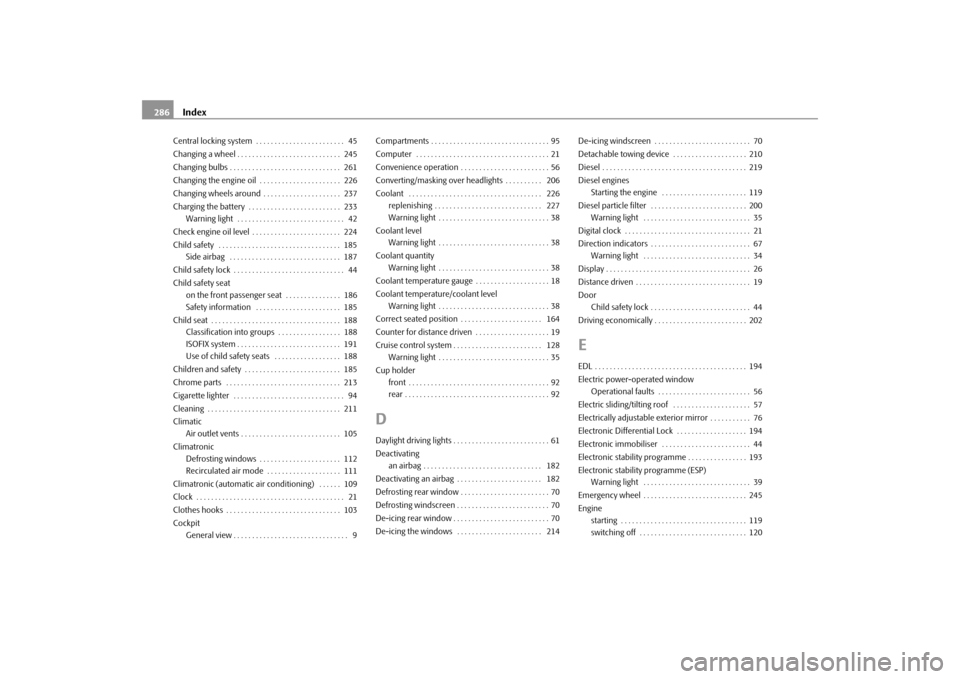
Index 286Central locking system . . . . . . . . . . . . . . . . . . . . . . . . 45
Changing a wheel . . . . . . . . . . . . . . . . . . . . . . . . . . . . 245
Changing bulbs . . . . . . . . . . . . . . . . . . . . . . . . . . . . . . 261
Changing the engine oil . . . . . . . . . . . . . . . . . . . . . . 226
Changing wheels around . . . . . . . . . . . . . . . . . . . . . 237
Charging the battery . . . . . . . . . . . . . . . . . . . . . . . . . 233
Warning light . . . . . . . . . . . . . . . . . . . . . . . . . . . . . 42
Check engine oil level . . . . . . . . . . . . . . . . . . . . . . . . 224
Child safety . . . . . . . . . . . . . . . . . . . . . . . . . . . . . . . . . 185
Side airbag . . . . . . . . . . . . . . . . . . . . . . . . . . . . . . 187
Child safety lock . . . . . . . . . . . . . . . . . . . . . . . . . . . . . . 44
Child safety seat
on the front passenger seat . . . . . . . . . . . . . . . 186
Safety information . . . . . . . . . . . . . . . . . . . . . . . 185
Child seat . . . . . . . . . . . . . . . . . . . . . . . . . . . . . . . . . . . 188
Classification into groups . . . . . . . . . . . . . . . . . 188
ISOFIX system . . . . . . . . . . . . . . . . . . . . . . . . . . . . 191
Use of child safety seats . . . . . . . . . . . . . . . . . . 188
Children and safety . . . . . . . . . . . . . . . . . . . . . . . . . . 185
Chrome parts . . . . . . . . . . . . . . . . . . . . . . . . . . . . . . . 213
Cigarette lighter . . . . . . . . . . . . . . . . . . . . . . . . . . . . . . 94
Cleaning . . . . . . . . . . . . . . . . . . . . . . . . . . . . . . . . . . . . 211
Climatic
Air outlet vents . . . . . . . . . . . . . . . . . . . . . . . . . . . 105
Climatronic
Defrosting windows . . . . . . . . . . . . . . . . . . . . . . 112
Recirculated air mode . . . . . . . . . . . . . . . . . . . . 111
Climatronic (automatic air conditioning) . . . . . . 109
Clock . . . . . . . . . . . . . . . . . . . . . . . . . . . . . . . . . . . . . . . . 21
Clothes hooks . . . . . . . . . . . . . . . . . . . . . . . . . . . . . . . 103
Cockpit
General view . . . . . . . . . . . . . . . . . . . . . . . . . . . . . . . 9Compartments . . . . . . . . . . . . . . . . . . . . . . . . . . . . . . . . 95
Computer . . . . . . . . . . . . . . . . . . . . . . . . . . . . . . . . . . . . 21
Convenience operation . . . . . . . . . . . . . . . . . . . . . . . . 56
Converting/masking over headlights . . . . . . . . . . 206
Coolant . . . . . . . . . . . . . . . . . . . . . . . . . . . . . . . . . . . . 226
replenishing . . . . . . . . . . . . . . . . . . . . . . . . . . . . . 227
Warning light . . . . . . . . . . . . . . . . . . . . . . . . . . . . . . 38
Coolant level
Warning light . . . . . . . . . . . . . . . . . . . . . . . . . . . . . . 38
Coolant quantity
Warning light . . . . . . . . . . . . . . . . . . . . . . . . . . . . . . 38
Coolant temperature gauge . . . . . . . . . . . . . . . . . . . . 18
Coolant temperature/coolant level
Warning light . . . . . . . . . . . . . . . . . . . . . . . . . . . . . . 38
Correct seated position . . . . . . . . . . . . . . . . . . . . . . 164
Counter for distance driven . . . . . . . . . . . . . . . . . . . . 19
Cruise control system . . . . . . . . . . . . . . . . . . . . . . . . 128
Warning light . . . . . . . . . . . . . . . . . . . . . . . . . . . . . . 35
Cup holder
front . . . . . . . . . . . . . . . . . . . . . . . . . . . . . . . . . . . . . . 92
rear . . . . . . . . . . . . . . . . . . . . . . . . . . . . . . . . . . . . . . . 92
DDaylight driving lights . . . . . . . . . . . . . . . . . . . . . . . . . . 61
Deactivating
an airbag . . . . . . . . . . . . . . . . . . . . . . . . . . . . . . . . 182
Deactivating an airbag . . . . . . . . . . . . . . . . . . . . . . . 182
Defrosting rear window . . . . . . . . . . . . . . . . . . . . . . . . 70
Defrosting windscreen . . . . . . . . . . . . . . . . . . . . . . . . . 70
De-icing rear window . . . . . . . . . . . . . . . . . . . . . . . . . . 70
De-icing the windows . . . . . . . . . . . . . . . . . . . . . . . 214De-icing windscreen . . . . . . . . . . . . . . . . . . . . . . . . . . 70
Detachable towing device . . . . . . . . . . . . . . . . . . . . 210
Diesel . . . . . . . . . . . . . . . . . . . . . . . . . . . . . . . . . . . . . . . 219
Diesel engines
Starting the engine . . . . . . . . . . . . . . . . . . . . . . . 119
Diesel particle filter . . . . . . . . . . . . . . . . . . . . . . . . . . 200
Warning light . . . . . . . . . . . . . . . . . . . . . . . . . . . . . 35
Digital clock . . . . . . . . . . . . . . . . . . . . . . . . . . . . . . . . . . 21
Direction indicators . . . . . . . . . . . . . . . . . . . . . . . . . . . 67
Warning light . . . . . . . . . . . . . . . . . . . . . . . . . . . . . 34
Display . . . . . . . . . . . . . . . . . . . . . . . . . . . . . . . . . . . . . . . 26
Distance driven . . . . . . . . . . . . . . . . . . . . . . . . . . . . . . . 19
Door
Child safety lock . . . . . . . . . . . . . . . . . . . . . . . . . . . 44
Driving economically . . . . . . . . . . . . . . . . . . . . . . . . . 202
EEDL . . . . . . . . . . . . . . . . . . . . . . . . . . . . . . . . . . . . . . . . . 194
Electric power-operated window
Operational faults . . . . . . . . . . . . . . . . . . . . . . . . . 56
Electric sliding/tilting roof . . . . . . . . . . . . . . . . . . . . . 57
Electrically adjustable exterior mirror . . . . . . . . . . . 76
Electronic Differential Lock . . . . . . . . . . . . . . . . . . . 194
Electronic immobiliser . . . . . . . . . . . . . . . . . . . . . . . . 44
Electronic stability programme . . . . . . . . . . . . . . . . 193
Electronic stability programme (ESP)
Warning light . . . . . . . . . . . . . . . . . . . . . . . . . . . . . 39
Emergency wheel . . . . . . . . . . . . . . . . . . . . . . . . . . . . 245
Engine
starting . . . . . . . . . . . . . . . . . . . . . . . . . . . . . . . . . . 119
switching off . . . . . . . . . . . . . . . . . . . . . . . . . . . . . 120
s2dk.1.book Page 286 Wednesday, April 8, 2009 12:23 PM
Page 288 of 294
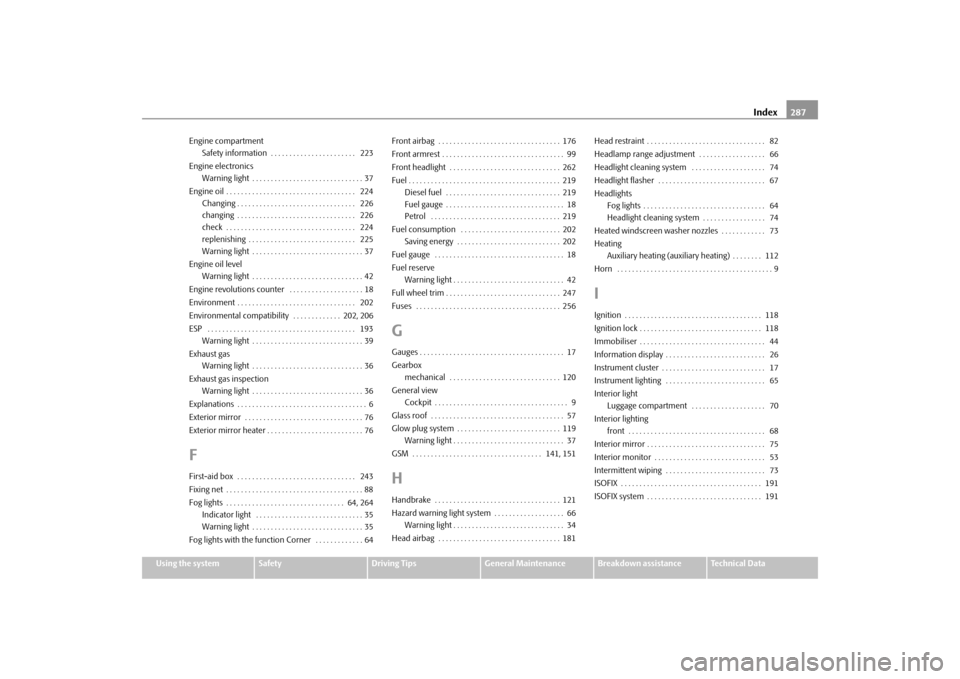
Index287
Using the system
Safety
Driving Tips
General Maintenance
Breakdown assistance
Technical Data Engine compartment
Safety information . . . . . . . . . . . . . . . . . . . . . . . 223
Engine electronics
Warning light . . . . . . . . . . . . . . . . . . . . . . . . . . . . . . 37
Engine oil . . . . . . . . . . . . . . . . . . . . . . . . . . . . . . . . . . . 224
Changing . . . . . . . . . . . . . . . . . . . . . . . . . . . . . . . . 226
changing . . . . . . . . . . . . . . . . . . . . . . . . . . . . . . . . 226
check . . . . . . . . . . . . . . . . . . . . . . . . . . . . . . . . . . . 224
replenishing . . . . . . . . . . . . . . . . . . . . . . . . . . . . . 225
Warning light . . . . . . . . . . . . . . . . . . . . . . . . . . . . . . 37
Engine oil level
Warning light . . . . . . . . . . . . . . . . . . . . . . . . . . . . . . 42
Engine revolutions counter . . . . . . . . . . . . . . . . . . . . 18
Environment . . . . . . . . . . . . . . . . . . . . . . . . . . . . . . . . 202
Environmental compatibility . . . . . . . . . . . . . 202, 206
ESP . . . . . . . . . . . . . . . . . . . . . . . . . . . . . . . . . . . . . . . . 193
Warning light . . . . . . . . . . . . . . . . . . . . . . . . . . . . . . 39
Exhaust gas
Warning light . . . . . . . . . . . . . . . . . . . . . . . . . . . . . . 36
Exhaust gas inspection
Warning light . . . . . . . . . . . . . . . . . . . . . . . . . . . . . . 36
Explanations . . . . . . . . . . . . . . . . . . . . . . . . . . . . . . . . . . . 6
Exterior mirror . . . . . . . . . . . . . . . . . . . . . . . . . . . . . . . . 76
Exterior mirror heater . . . . . . . . . . . . . . . . . . . . . . . . . . 76
FFirst-aid box . . . . . . . . . . . . . . . . . . . . . . . . . . . . . . . . 243
Fixing net . . . . . . . . . . . . . . . . . . . . . . . . . . . . . . . . . . . . . 88
Fog lights . . . . . . . . . . . . . . . . . . . . . . . . . . . . . . . . 64, 264
Indicator light . . . . . . . . . . . . . . . . . . . . . . . . . . . . . 35
Warning light . . . . . . . . . . . . . . . . . . . . . . . . . . . . . . 35
Fog lights with the function Corner . . . . . . . . . . . . . 64Front airbag . . . . . . . . . . . . . . . . . . . . . . . . . . . . . . . . . 176
Front armrest . . . . . . . . . . . . . . . . . . . . . . . . . . . . . . . . . 99
Front headlight . . . . . . . . . . . . . . . . . . . . . . . . . . . . . . 262
Fuel . . . . . . . . . . . . . . . . . . . . . . . . . . . . . . . . . . . . . . . . . 219
Diesel fuel . . . . . . . . . . . . . . . . . . . . . . . . . . . . . . . 219
Fuel gauge . . . . . . . . . . . . . . . . . . . . . . . . . . . . . . . . 18
Petrol . . . . . . . . . . . . . . . . . . . . . . . . . . . . . . . . . . . 219
Fuel consumption . . . . . . . . . . . . . . . . . . . . . . . . . . . 202
Saving energy . . . . . . . . . . . . . . . . . . . . . . . . . . . . 202
Fuel gauge . . . . . . . . . . . . . . . . . . . . . . . . . . . . . . . . . . . 18
Fuel reserve
Warning light . . . . . . . . . . . . . . . . . . . . . . . . . . . . . . 42
Full wheel trim . . . . . . . . . . . . . . . . . . . . . . . . . . . . . . . 247
Fuses . . . . . . . . . . . . . . . . . . . . . . . . . . . . . . . . . . . . . . . 256
GGauges . . . . . . . . . . . . . . . . . . . . . . . . . . . . . . . . . . . . . . . 17
Gearbox
mechanical . . . . . . . . . . . . . . . . . . . . . . . . . . . . . . 120
General view
Cockpit . . . . . . . . . . . . . . . . . . . . . . . . . . . . . . . . . . . . 9
Glass roof . . . . . . . . . . . . . . . . . . . . . . . . . . . . . . . . . . . . 57
Glow plug system . . . . . . . . . . . . . . . . . . . . . . . . . . . . 119
Warning light . . . . . . . . . . . . . . . . . . . . . . . . . . . . . . 37
GSM . . . . . . . . . . . . . . . . . . . . . . . . . . . . . . . . . . . 141, 151HHandbrake . . . . . . . . . . . . . . . . . . . . . . . . . . . . . . . . . . 121
Hazard warning light system . . . . . . . . . . . . . . . . . . . 66
Warning light . . . . . . . . . . . . . . . . . . . . . . . . . . . . . . 34
Head airbag . . . . . . . . . . . . . . . . . . . . . . . . . . . . . . . . . 181Head restraint . . . . . . . . . . . . . . . . . . . . . . . . . . . . . . . . 82
Headlamp range adjustment . . . . . . . . . . . . . . . . . . 66
Headlight cleaning system . . . . . . . . . . . . . . . . . . . . 74
Headlight flasher . . . . . . . . . . . . . . . . . . . . . . . . . . . . . 67
Headlights
Fog lights . . . . . . . . . . . . . . . . . . . . . . . . . . . . . . . . . 64
Headlight cleaning system . . . . . . . . . . . . . . . . . 74
Heated windscreen washer nozzles . . . . . . . . . . . . 73
Heating
Auxiliary heating (auxiliary heating) . . . . . . . . 112
Horn . . . . . . . . . . . . . . . . . . . . . . . . . . . . . . . . . . . . . . . . . . 9
IIgnition . . . . . . . . . . . . . . . . . . . . . . . . . . . . . . . . . . . . . 118
Ignition lock . . . . . . . . . . . . . . . . . . . . . . . . . . . . . . . . . 118
Immobiliser . . . . . . . . . . . . . . . . . . . . . . . . . . . . . . . . . . 44
Information display . . . . . . . . . . . . . . . . . . . . . . . . . . . 26
Instrument cluster . . . . . . . . . . . . . . . . . . . . . . . . . . . . 17
Instrument lighting . . . . . . . . . . . . . . . . . . . . . . . . . . . 65
Interior light
Luggage compartment . . . . . . . . . . . . . . . . . . . . 70
Interior lighting
front . . . . . . . . . . . . . . . . . . . . . . . . . . . . . . . . . . . . . 68
Interior mirror . . . . . . . . . . . . . . . . . . . . . . . . . . . . . . . . 75
Interior monitor . . . . . . . . . . . . . . . . . . . . . . . . . . . . . . 53
Intermittent wiping . . . . . . . . . . . . . . . . . . . . . . . . . . . 73
ISOFIX . . . . . . . . . . . . . . . . . . . . . . . . . . . . . . . . . . . . . . 191
ISOFIX system . . . . . . . . . . . . . . . . . . . . . . . . . . . . . . . 191
s2dk.1.book Page 287 Wednesday, April 8, 2009 12:23 PM